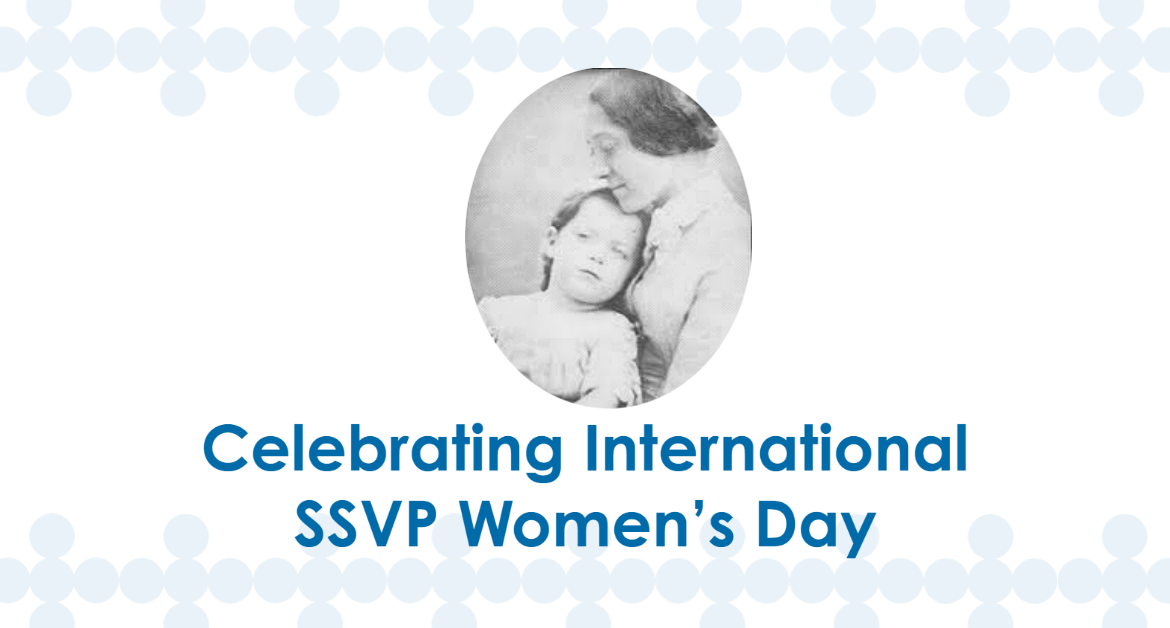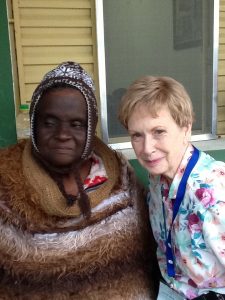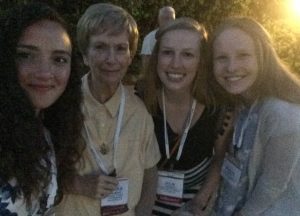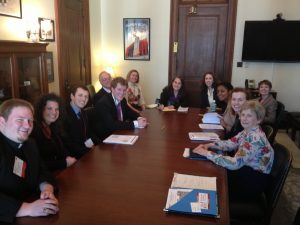On August 14, the Society of St. Vincent de Paul celebrates International SSVP Women’s Day. The date was chosen in honor of Amelie Ozanam’s birthday, and has been expanded to reflect the history and heritage of women who have served in the Society across the world.
The first recorded “Women’s Society of St Vincent de Paul” was founded in Italy in 1856. The Women’s Society followed the same Rule and operated for more than 200 years, until 1968, when women were formally accepted into the Society as full Active members. At that time, there remained women-only and men-only Conferences. But new Conferences were encouraged to invite Members of both sexes.
Categories of Membership included Active (same as it is today), Subscriber (essentially “Contributing Members”), and Honorary. The Honorary category was a bit vague in its definitions, but sometimes women were accepted as Honorary Members, and allowed to go on Home Visits and participate in other works. It should be noted that this was not the purpose of Honorary Membership, and that Conferences were advised that they should not do this.
Though women could not formally become Active members, their work with the Society was essential, because early editions of the Rule advised that men were not allowed to go visit young women for reasons of propriety:
“Young women, particularly if they live by themselves, should not be visited
by the members on any account, their wants had better be referred to one or
more charitable women, if no female, charitable or benevolent society exist. [Rule, 1906]
Prior to the Women’s Society of St Vincent de Paul, there were some locally established “Ladies Auxiliaries” formed, possibly as early as the 1830s. Women who served in the Auxiliaries (or as Honorary members) enabled Conferences to assist more people if there was no other local organization to whom they could refer women for assistance.
Here, we share two articles enlightening articles on the subject of women in the Society. The first article is from The Manual, 1980 edition:
Membership of Women
The admission of women into Vincentian ranks came as a somewhat recent historical development. When the Society was first established in 1833 at Paris by college students, membership was restricted to males. Considering the prevailing culture, this outcome could hardly have been otherwise. At the University of Paris in 1833, there were no coeds. In 1833, woman’s education and employment, as well as her opportunities to participate in social, cultural or political life, were extremely limited.
But Vincentian men have always worked with women. Religious women helped start the Society. “Let us go to the poor” was the good resolve of the young University men. But where are the poor? How does one “go” to honor and not to humiliate? The Sisters of Charity of St. Vincent de Paul gave both the addresses and entree. Paris’ apostle among the poor, Sister Rosalie, gave Vincentians invaluable advice and also their first bread and meat tickets.
In the early years of the Society, women participated by their prayers, inspirations, and encouragement. So that a husband member might make his visits to the poor, the wife sacrificed her own hours of companionship with him.
In 1856, the need of plague victims gave birth to them Women’s Society of St. Vincent de Paul, headquartered at Bologna, Italy. Until 1960, this women’s Society, with its own Council General, was entirely distinct from the men’s Society, although both followed exactly the same Rule. This feminine Society became strongest in Italy, Portugal and Canada.
The actual working together of men and women within the SVDP Society – and indeed within the Catholic Church – gradually evolved. The Magna Carta of Christian women in our day dates to October 21, 1945, when Pope Pius XII gave his comprehensive address on “Women’s Duties in Social and Political Life.” In it he emphasized the vast field of activity which now lies open to women, “‘in education” and in “direct participation” and “effective collaboration in social and political activity.” He said: “Associated with men in civil institutions she will apply herself especially to those matters which call for tact, delicacy and maternal instinct.” To the questions and problems that “call for study and action on the part of governments and legislators, he said, “only a woman will know how to temper certain legislation with kindness, without detriment to its efficacy.”
The Society too reflected the change in outlook that was taking place in the world and within the Church. At the Plenary Meeting of the Society in 1960, adopted resolutions sanctioned enlargement of the Society through mixed (male/female) Conferences. At the 1963 international SVDP sessions, the process of gradually integrating the women’s conferences that had been admitted through Bologna into the parent SVDP structure at Paris was approved. Within a few years a single Society – embracing Conferences of men only, women only and mixed groups – emerged.
In the United States the original response to the reception of women as members tended to be cautious, rather than positive and enthusiastic. In 1969, however, the national trustees at their annual meeting in Houston, Texas elected T. Raber Taylor of Denver, who had for a number of years championed the cause of women in the Society. From that time, the door was opened wide and a number of women began to enroll as active members.
This progression, however, was uneven, depending upon local SVDP leadership and circumstances. In 1976 to overcome any reluctance and inertia on the part of USA Vincentians and to augment the participation of women in the Society, a committee of women was formed as a subcommittee of the National Extension Committee. Its basic purpose has been to encourage the recruitment of women. The committee is called Women in the Society or briefly WIS. It is composed of eight Regional Representatives, four women advisors, and a chairperson. Each Regional Representative has been committed to forming her own Regional WIS committee among the Dioceses listed in her Region. She teams with the Regional Extension Chairman.
Today’s newly organized parish Conferences usually aim from the outset to recruit both men and women as members. It would be unusual for new parish SVDP groups to take a different tack, considering how important it is that women become fully involved as members and leaders in the life of the Church and parish.
Although some women may by temperament and insight be more comfortable and skilled in working with female clients, there appears to be little inclination on the part of Vincentian units to prejudge roles and assignments for women members. Women members. like their male counterparts, can be very much at home with any kind of family problem
The Catholic Historical Review
The below is an excerpt from The Catholic Historical Review , Jan., 1922 by Charles L. Souvay, CM, DD:
But what I have in view is, that in the visitation and relief of the poor in their homes, there are many things that men cannot do; there are conditions that they never know, because either it takes a woman’s keen eye to detect them, or else they are confided only to the doctor or to a female confidante. Shall this vast portion of the work remain undone, for the reason that women cannot become either active or honorary members of the Society of St. Vincent de Paul? If it were so, then we should say that Catholic charity has lost her clearsightedness and has “fallen away.” But it is not so. All Conference men are agreed that the help of the gentler sex is a necessity: if ladies are debarred from membership in the Society, they can be subscribers and benefactresses; they can be friendly visitors, and in this capacity render most valuable assistance. The desire has been strongly voiced that there should be a Ladies’ Auxiliary wherever there is a Conference, and much has been done already to promote the institution of such Auxiliaries. May I suggest that the type of these Ladies’ Auxiliaries has been realized for upwards of three hundred years in the Confraternities of the Ladies of Charity? 18 Inaugurated by St. Vincent de Paul at Châtillon-les-Dombes in August, 1617, they were established, some twenty years later, in every parish of Paris and its suburbs, and in many other places throughout the kingdom, even at the court itself. This is not the place to expatiate upon the services rendered by them in visiting the poor sick in their homes, or in the Paris Hôtel-Dieu, in looking after foundlings and-we almost seem to speak here of our own times, not of the seventeenth century in rehabilitating the war-devastated regions of Lorraine, Picardy and Champagne, caring for their plague and famine-stricken populations, distributing among them immense stores of clothing, securing homes for the war orphans, and employment for young girls driven out of their deserted homes. I briefly mention this much merely to emphasize the analogy between the works of the St. Vincent de Paul Society and those of the Ladies of Charity. From this analogy naturally flows the conclusion, which the resemblance of their Rules would render yet more forcible, that in a cooperation of these two institutions, which both claim the name and patronage of the same “Father of the Poor,” we Catholics have a matchless agency of reconstruction. Women cannot be aggregated to the Conferences; men have no place in the Confraternities of Charity. So be it. But who will say that an entente cordiale is impossible between these two institutions? Such an entente has been effected in various places, to the entire satisfaction of all concerned, and, first of all, of the poor. Ab actu ad posse valet consecutio.





